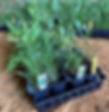Fall maintenance tips for pollinator gardens
- Shelby Roberts
- Oct 3, 2022
- 3 min read
Updated: Nov 2, 2022

With beautiful, cool fall weather on the horizon, it’s time to start “putting your garden to bed”. Seasonal maintenance is necessary for any landscaping project. And while it is practical to remove debris and dead leaves from your vegetable or annual garden, pollinator plantings and native perennial gardens require slightly different treatment.
For new and established native gardens alike, here are some things you can do to prepare your garden for the long winter and make sure you’re providing the best habitat possible for the pollinators and wildlife.
Leave your leaves
The easiest cleanup is no cleanup! As your perennial plants shed their leaves and go dormant, it is best to leave fallen debris and plant twigs where they lie. By leaving twigs, leaves, and brush on your garden floor, and not covering it up with mulch or exposing the bare soil, you create a dynamic landscape that pollinators can bunk down and lay their eggs in.

Just like chipmunks build up nests to hibernate in, some pollinating insects do the same! Bumblebees specifically will leave their summers nests and the queen will search for suitable groundcover like leaf litter or old rodent holes to make a winter home. Non-migratory butterflies will also take shelter underneath loose soil. The left-over debris creates insulation and protection for pollinators, preserves soil moisture and nutrients, suppresses spring weeds, and reduces your yard waste.
Trim stems. Don’t chop.
Hollow stems are also important nesting habitat for many beneficial bees. When trimming your plants after they’ve gone dormant for the year, native perennial stems should be left at least six inches tall. By doing this, you leave enough of the plant behind to give it a good base for growing in the spring, while also providing nesting habitat for pollinators. For extra stem leftovers, tie them in a bundle with twine and leave them sitting horizontally in a sunny patch with one end of the stems covered. Bees will find a happy home in either location.
Collecting seeds
Late fall—right before frost and snow set in—is the perfect time to harvest native seeds from your garden. Typically, seeds are ready for harvest 2-5 weeks after their peak bloom and until the season’s first frost. In order to give your garden plenty of time to establish itself and build up a seed bank in the soil, it is best not to harvest seeds until a pollinator planting or native grass seeding is around 3-5 years old.

Pay attention to the look and feel of the seeds you harvest. Whether you are harvesting by hand or by mechanical means, mature, ready-to-harvest seeds are generally dry, firm and dull in color. Their seed pods should easily break off the main plant with little resistance. For a complete guide to harvesting both perennial and annual seeds, visit the Xerces society’s guide to Collecting and Using your own Wildflower Seed.
Be sure to leave some seeds still on the ground over winter. Songbirds will be grateful for the snack when the ground melts next spring. As a rule of thumb, leave at least 80% of available seed in your garden to overwinter.
Make note of bare patches
Fall is a great time to identify any patches or areas of your garden that have become sparse over the year and might need some extra TLC to flourish again. If you’ve done any seed collecting, fall is a great time to strategically spread fresh seed around any bare patches to give them a chance to sprout next spring. Be sure to establish good seed-to-soil contact before spreading. You can help incorporate seeds into the soil by lightly raking the area where seeds were recently spread. No watering is necessary for fall seedings.
Plan for next spring
Alternatively, if you would rather spruce up bare patches with fuller, live plugs, the Scott SWCD hosts a native plant kit sale every spring where you can buy specialized kits of 36 native plants. Each kit contains 6 different species that bloom throughout the growing season and the 1” plants transplant easily and establish quickly. To sign up for email notifications for when the Scott SWCD plant sale opens, visit scottswcdtrees.com or call 952-492-5425.
If you are interested in installing a native pollinator garden, the Scott SWCD is here to help. We can help you create a plan, put together a plant list, guide you through site preparation and installation, and offer you support through long-term maintenance, so your planting stays vibrant and beautiful.
We can also discuss financial assistance options that you may be eligible for. To get the process started, or for any additional fall garden maintenance questions,
call the us at 952-492-5425.
